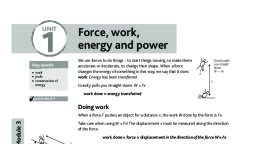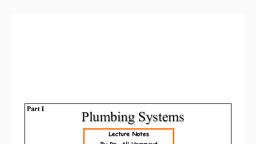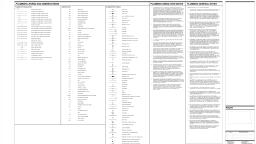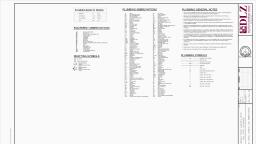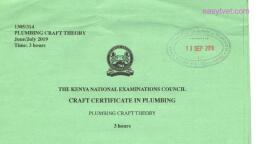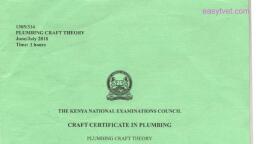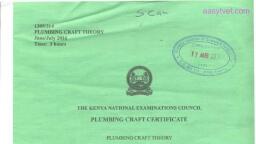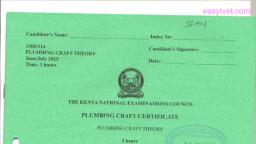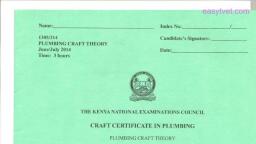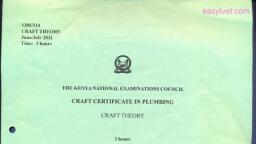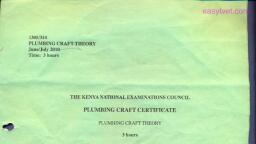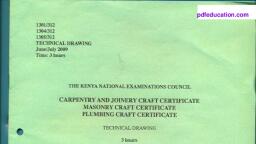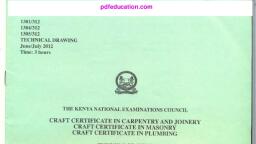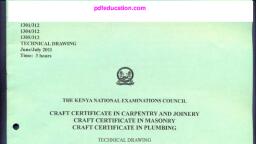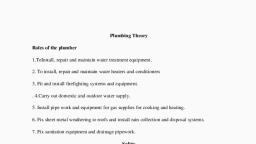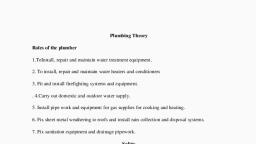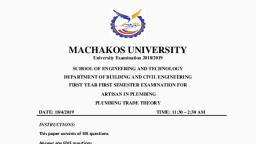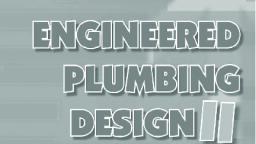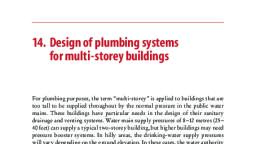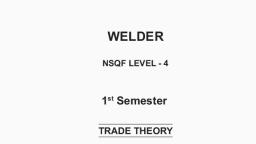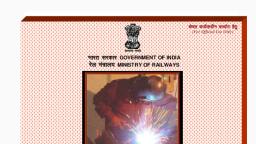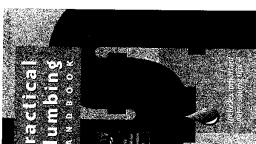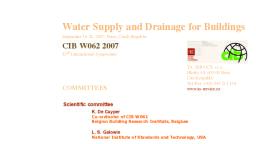Page 1 :
Plumbing Theory, Roles of the plumber, 1.ToInstall, repair and maintain water treatment equipment., 2. To install, repair and maintain water heaters and conditioners, 3. Fit and install firefighting systems and equipment., . 4.Carry out domestic and outdoor water supply., 5. Install pipe work and equipment for gas supplies for cooking and heating., 6. Fix sheet metal weathering to roofs and install rain collection and disposal systems., 7. Fix sanitation equipment and drainage pipework., Safety, The health and safety of people working in the plumbing industry is a major concern for the, plumbers., Plumbing contributes to many construction accidents statistics recorded., In many countries have introduced lawsdemanding both employers and employees to observe, strict health and safety procedures in the work places., Personal Protection, Wherever possible and regardless of the job a plumber is undertaking. He/ she must ensure that, his/ her safety first., Several protective clothings have been designed to ensure personal protection. They include, Overalls, Overalls are designed to prevent everyday clothing from becoming contaminated by oil, grease,, fluxes or general dust and dirt., Always wear Overalls to cover loose clothing eg ties which could be caught in moving parts of, machines., 1
Page 2 :
Safety helmet or Hard hat, Helmets are usually made of toughened plastic or steel., Always wear a helmet to protect a person against injuries caused by falling objects., , Safety Goggles, These are clear safety googles, Always wear clear googles to protect yourself from airborne dust and debris from getting in to, your eyes., , 2
Page 3 :
Welding Goggles, They have dark or shaded lenses., Always wear welding googles to protect the eyes from intense bright light or sparks created by, arc welding and gas welding, , Gloves, Gloves are worn to give wide range of protection., Always wear rubber and plastic gloves to give protection against skin irritation when handling, cement, oil or grease., Always wear heavy duty gloves to give protection against injuries when handling materials with, sharp edges like glass., , 3
Page 4 :
Face Mask, This is a safety equipment used to cover the mouth and nose., Always wear face mask when working in area with high concentration fumes and dust for, protection against inhalation problems., N/B keep working area tidy to ensure that jobs are carried out more safely and efficiently., Safety in the workshop, , , Keep work benches and machines clear of unnecessary tools and materials, and free of, scraps and offcuts., , , , Remove all combustible materials eg timber and papers because they can promote fire, hazards in the workshop., , , , Sweep floors and workbenches to remove shavings, metal of cuts and general rubbish., , , , Check benches regularly to make sure that there are no protruding nails and screws that, could cause injuries., , , , Ensure work benches are secure, solid and level., , , , Ensure all workbench’s equipment eg pipe vives are fixed securely., , , , Never leave long pipes protruding from pipe vice for they can cause injury., , , , Ensure all machines and equipment in the workshop are fitted with appropriate, protective guards and all safety procedures displayed alongside the machine., , , , Ensure all electrically powered machines are fitted with a safety ‘panic button’ shut off, switch which is visible and painted in a distinctive colour., , , , In workshop where welding, brazing or soldering is taking place, ensure suitable, ventilation to remove fumes., , Safety When Handling Hand Tools., , , Keep all blades and cutting surfaces sharp and if possible covered when not in use., , , , Never use file and similar tools without handles., , , , Ensure Wedge head of all hammers are securely fixed to prevent them from flying off, during use and causing injuries., , , , Only use correct size of screw drivers when fixing screws., , 4
Page 5 :
, , Ensure that all cables for portable electric power tools are securely fixed to the terminals, and cables are not damaged., , Safety in Building Sites., Most accident on building sites result from people falling from the ladder, working platforms or, scaffolds or buildings themselves., Falling objects, tools and materials also contribute to fine share of accident in the site., With suitable precautions taken, the potential accidents are greatly reduced., Safety on Ladders, , , Never extend ladders above to third of the extension length, otherwise they become, unstable., , , , If a ladder cannot be repaired properly. Scrap it., , , , Ladders should never be painted, because paints may hide defects., , , , The foot of the ladder should be level and securely anchored if it is on the soil., , , , Never reach too far off a ladder to save time., , , , Always rub off mud and clay off your shoes or boots before climbing the ladder to, prevent slipping., , Scaffolds and working platforms., Scaffold is a temporary structure used to support a work crew and materials to aid in the construction, , Safety on scaffolds and platforms, , , Never use stepladders on top of working of working platform or scaffolds to gain extra, height., , , , Whenever working near scaffolds wear a safety helmet, , , , Never overload a working platform or scaffold with tools and materials because they, may cause it to become unstable., , , , Never use timber that has seen a lot of wear and tear to make scaffolds., , 5
Page 6 :
Fire Prevention., You can deal with small fire quickly and effectively by using appropriate fire extinguishers., The fire extinguishers work by cutting off oxygen supply to the fire or making burning material, temporary incombustible by soaking water in it., There 5 main types of fire extinguishers used to fight different types of fire., Type of fire extinguisher, , Colour of container, , Water Fire Extinguisher, , Red, , Form Fire Extinguisher, , Cream, , Dry Powder Fire Extinguisher, , Blue, , CO2 fire extinguishers, , Black, , Wet Chemical Extinguisher, , Yellow, , Class of Fire, Class A, , Materials involved, Caused by flammable materials such as, , Fire Extinguisher used, Water Fire Extinguisher, , wood, paper and fabric, Class B, , Caused by flammable liquids such as, , Form Fire Extinguisher, , petrol, turpentine or paints, Class C, , Caused by Flammable gases eg, , Dry Powder Fire Extinguisher, , hydrogen, butane or methane, Class D, , Caused by flammable metals eg, , Dry Powder Fire Extinguisher, , magnesium or potassium, Electrical fires, , Caused by electrical equipment, , CO2 fire extinguishers, Dry Powder Fire Extinguisher, , Class F, , Fire caused by Cooking oils, typically, chip pan fire., , 6, , Wet Chemical Extinguisher
Page 7 :
Tools and Equipment, All plumbers should understand common tools, their uses and tips to get the best out of one’s tools., A good plumber never blames his/her tools for a job that goes wrong and mistakes made., The most common plumbing activities involve the following., , , , , , , Measuring, Cutting, Bending, Jointing, Fixing and installing, , There are several tools used in relation to the above activities carried out by a plumber., Measuring Tools, Most popular measuring tools used by plumbers are, , , Tape measure, This is a flexible ruler used to measure distance., , 7
Page 8 :
, , Steel Rule, This is a strip of metal graduated in inches and fractions of inches to give actual, measurements., , Measuring Square, A square is primarily used to keep things perpendicular., , NB: when measuring length of pipework to be cut, remember to allow for depth of socket on, fittings., , 8
Page 9 :
Cutting Tools., Variety of cutting tools are used by plumbers to cut and bend various materials used in plumbing, pipework., Pipe vice, A pipe vice is used to hold pipes when cutting, filling, reaming, bending, cutting threads or any other, operation on pipes., Pipe vices are designed to grip pipes equally around the its circumference to prevent deformation of, pipe walls., They are available as free – standing, portable site vices or fixed bench vices, , Hacksaw, Hacksaw is mainly used for cutting pipes of various materials but also used for cutting steel bars and, bolts., There are mainly two types of types of hacksaws., , , , Adjustable frame hacksaw – uses blade between 250 and 300mm long, Junior hacksaw – uses a blade approximately 150mm long., , A wing nut at the end of the adjustable frame hacksaw always to change the size and increase, tension on the blade., , 9
Page 10 :
Precautions taken when using a hacksaw., , , , , , , , Always check the measurement and markings are correct before starting the cutting, Always stand comfortably with the feet slightly spread to provide a sound base, Always cut slowly with pressures of forward stroke only., Make sure the blade is at 900 to the pipe and vertically straight on pipe, to ensure a straight, cut., Always make sure that the blade is fixed with teeth facing forward., Never used blades that are worn or have missing teeth., , Wheel Pipe cutter, They are used for small and large pipe cutting., The single wheel cutter has 1 cutting wheel and 2 guide wheels., The pipe is placed at 900 so that both guide wheels are in contact with the pipe., The adjustable handle is turned to bring the cutting wheel in to contact with pipe., The handle turns the whole tool completely around the pipe through 3600. This increases the pressure, from the cutting wheel until it eventually cuts the pipe., , Pipe Reamer., This is a purpose made tool used to remove internal burrs from steel or copper pipes., They are usually cone – shaped with several cutting edges which can either be hand – turned or, machine – turned., NB: Burrs are rough edges or ridges left on objects after an action of tools., , 10
Page 11 :
Files, Files are used for general shaping and the preparation of pipes before jointing, including removal of, burrs and swarf., NB: fine chips or fillings of a material produced after a machine or tool operation., , Precaution when using a file, , , , , , , Before using a file make sure that the handle is sure with teeth free from metal swarf. If, necessary, brush the file with a wire brush to clean., Make sure you are standing in a comfortable position with your feet spread out form a sound, base., Never use a file without a handle., Never run the fingers over the edges of pipes to check the cut., Make sure that the file is cutting on the forward stroke only., , Hole Saws or Hole cutters., They are used for cutting holes on plastic pipes, steel and plastic tanks and sheet metal., , 11
Page 12 :
Padsaw/ Compass saw, Blades are fixed on one end, in wooden or metallic handle., They are used for cutting holes in sheet materials and sawing in restricted positions where a hacksaw, will not fit., , Bending Tools, Bending is done to change direction of pipe work., Using special purpose fitting or joints can be expensive where you need a lot of fittings and some bends, cannot be easily made from available fittings. In this case you will have to bend the pipe yourself., The method used will be governed by the size and type of pipe used., In most situation, the easiest way to bend is using a machine., , Hydraulic Pipe Bender, A hydraulic pipe bender bends pipe of various sizes., , 12
Page 13 :
Using a hydraulic pipe bender, , , , , , , , , Mark the bending distance from the end of the pipe (former mark)., Deduct from the diameter from the measured distance and make a fresh new mark. This gives, an allowance of the centre of the pipe to accommodate the gain in length after bending., Put the stops and pins in the correct position and choose the correct size horse shoe., Position the pipe in the machine against the stops with the centre line between the two marks, made (Former and fresh mark)., Close the hydraulic cylinder bleed valve to build up the pressure for pumping., Pump the machine carefully until the suitable bend is obtained., When you are satisfied with the bend, open the valve of the hydraulic machine to pump to, lower the hydraulic cylinder., , Safety precautions for hydraulic pipe bender, , , , Always make sure oil in the machine is kept topped up according to manufacturer’s, requirement., Never leave any machine part on the floor where it could be damaged or cause safety, hazards., , Bending Springs, A pipe bending spring is a strong, flexible spring that is inserted into (or over) a pipe to support the, walls of the pipe when manually bending., , Heat bending, Steel pipe and plastic pipe can also be bent by loading the pipe with dry sand, heating it up in a, furnace or oxyacetylene flame and then bending., NB: The sand must be clean and dry with no debris or large particles., Make sure you heat the correct heat length because if you heat so much the pipe radius will be too, big and if you heat too little the radius will be to small and the pipe may kink., , 13
Page 14 :
Jointing Tools, The formation of joints in various materials is an essential part of the installation and maintenance, of pipe work systems and components., Stocks and Dies, These are used to form threads on the end of steel pipes prior to joining., The stock is the main body of the tool including the handle., The chaser contains a set of four dies which cut threads within a certain range of sizes., , Threading Machine, This is a multipurpose machine that includes a pipe cutter, reamer and chase dies., Threading machines can cut dies on pipe from 6 mm to 150mm diameter., , 14
Page 15 :
Pipe wrenches, They are used for tightening and loosening fittings and pipes., Stilson pipe wrench, This is a general purpose pipe wrench with adjustable jaws., Stilson are available in different sizes to suite range of pipes up to 150mm., , Chain wrench, They are used for tightening pipes of fittings because the chain grips right around the pipe, gripping, it against the teeth of the wrench., , 15
Page 16 :
Footprint pipe wrench, This is an adjustable pipe wrench is available in different sizes but is normally used for small diameter, pipe., , Spanners, These are used for tightening or loosening nuts and bolts of all sizes. There three main types of, spanners., , , , , Adjustable spanner, Open – ended fixed spanner, Ring spanner., , Adjustable Spanner, , 16
Page 17 :
Open – ended fixed spanner, , Ring spanner., Fixing and installing Tools, The tools are used for fixing and installing including general tools used by plumbers., Spirit Level and Plumb bob, These are tools used for setting out horizontal or vertical pipe work runs so that when clips and, brackets are fixed will be horizontally level or vertically plump., They are used to level appliances and component during installation., , 17
Page 18 :
Drills, These are used to make holes in metals, plastics wood and masonry., They consist drill bits, which actually makes the hole, and the drill itself which turns the drill bit., , Drill bit, , Centre Punch, It is used to make an identification in the materials will prevent the drill from slipping when making, holes., , Screw driver, It is used to drive in or remove screws, , 18
Page 19 :
Pliers, They are used for general purpose gripping action and remove nails., , Chisel, They are used for cutting holes through concrete, stone and brickwork walls., , Hammers, , A hammer is a tool consisting of a weighted "head" fixed to a long handle that is swung to, deliver an impact to a small area of an object, , 19
Page 20 :
Mallets, , A mallet is a kind of hammer, often made of rubber or sometimes woodand usually has a, relatively large head., , 20
Page 21 :
Materials, As a plumber, you will use many different kinds of material and they will come in a variety of, forms., Many will be metals, however, and most of this will be in the form of pipes, fittings, taps and, valves., NB: plastics have become one of the plumber’s favored materials because of their ease use and, relatively low cost., Nonmetallic materials such as ceramics, are important in plumbing., This chapter introduces a plumber to the materials, he or she is likely to come across, both, nonmetal and metal., This chapter also deals with taps, valves and other flow - control fittings., Plastics, The use of sythentic plastics, derived from from oil products has recently transformed the, plumbing industry., Plastic has replaced many traditional plumbing materials for the manufacture of wide range of, domestic and industrial plumbing. These materials include pipes, joints, valves, gutters, cistern, and some sanitary appliances., Advantages of plastic material in plumbing, , , They are light and flexible, , , , They have a high resistance to corrosion., , , , They do not contaminate water or fluid being transported., , , , They are cheap compared to other plumbing materials., , 21
Page 22 :
Most commonly used plastics include., 1. PE – Polythene., 2. PVC – Poly Vinyl Chloride., 3. UPVC - Unplasticized Polyvinyl Chloride, 4. CPVC - Chlorinated polyvinyl chloride, 5. PPR- Polypropylene Random, 6. HDPE - High Density Polyethylene, Ceramics, These are inorganic non-metallic solid made up of either metal or non-metal compounds that, have been shaped and then hardened by heating to high temperatures, In plumbing, ceramics are used mainly for sanitary appliances eg water closet and wash hand, basin., They are also used for underground drainage pipes., Concrete, This is a mixture of sand, stone and cement together with water in various quantities., Concrete pipes are mainly manufactured for use in large drainage or sewerage projects., Metals, Properties of metals, Brittleness: a property of metals which states that they do not deform under load but suddenly, break., Coefficient of linear expansion:This is a figure that indicates the amount a material will, expand when heated by 1o c., Colour: this is the visual appearance of a metal and important for identification purpose., Creep:Tendency of a solid material to move slowly or deform permanently under the influence, of its load., Density:this is the mass per unit volume measured in kilograms per cubic metre (kg/m3), , 22
Page 23 :
Ductility:the physical property of a material associated with the ability to be hammered thin or, stretched into wire without breaking., Durability:the is the ability to remain strong and sound for a long time over a long period of, time., Elasticity:this is the ability of a metal to go back to its original position shape after being, distorted under load., Fatigue:this the point when a metal fails or fractures when subjected to variation in direction of, applied pressure., Hardness:The ability of a material to resist scratching or cutting., Malleability: physical property of metals that defines the ability to be hammered, pressed or, rolled into thin sheets without breaking, Melting point:this is the temperature at which a metal changes from a solid to a liquid., Plasticity:the ability of a solid material to undergo a non-reversible change of shape in response, to applied forces., Specific gravity: this the number that denotes the weight of a materials in relation to water., Example lead has specific gravity of 11.3. which means it is 11.3 times heavier than water., Tenacity: this the ability of a metal to withstand compression or fracture when opposite pulling, forces are applied., Thermal Conductivity: this is the degree to which material will transmit heat by conduction., Annealing: this the heat treatment that alters the physical properties and reduce hardness., Case hardening: process used to increase the hardness of a metal by heat., Normalising: This is the process of heating and slowly cooling metals to alter the, microstructure of the metal which in turn reduces its hardness and increases its ductility., Toughness:the ability of a material to absorb energy and plastically deform without fracturing., , 23
Page 24 :
Metals can be classified into:, I., , Ferrous metals, Non – ferrous metal, , II., , Ferrous metal, This is the metal that contains iron., They are magnetic and give little resistance to corrosion., They include, I., , Think steel, , II., , stainless steel, , III., , carbon steel, , IV., , cast iron, , V., , Chromium, , VI., , Nickel, , VII., , Titanium, , Non Ferrous metal., This are metals that do not contain iron., They are usually more corrosion resistance., They include:, , , Aluminium, , , , Copper, , , , Lead, , , , Tin, , , , Zinc, , 24
Page 25 :
Iron and steel, Iron and steel are among the most commonly used materials by plumbers., Iron, Iron is further classified into, I., , Cast iron, , II., , Malleable iron, , III., , Wrought iron, , Cast iron., Cast iron is iron with relatively high carbon content and also contains manganese, phosphorous,, silicon and Sulphur., Properties of cast iron, , , It is durable and hard, , , , It is brittle, , Uses, Used for manufacture of baths, boilers, cistern, pipes and tanks, Malleable iron, It has similar content elements as the cast iron but under heat treatment it develops great, strength and ductility., Properties of malleable Iron, , , It has high strength and ductility., , Uses, Used to make threaded fittings for steel pipes, , 25
Page 26 :
Wrought Iron, Wrought iron has a small amount of carbon content., Properties of wrought iron, , , Great resistance to corrosion., , , , It is soft., , Uses, , , used to make rivets., , , , Making plates, , Steel, It is composed mainly of iron with addition varying amounts of carbon., The amount of carbon added to the iron is dependent on its use, the higher the amount of carbon, added the harder the metal will be., low carbon or mild steel, For most pressure pipework, low carbon or mild steel is used, which contains between 0.1%, carbon and 0.3% carbon. This makes it easy to bend yet strong against impact damage., Stainless steel, Stainless steel that contains both chromium and nickel is the most popular., It has bright silver colour., Galvanised Steel., This is mild steel with a coating of zinc applied to protect it against corrosion., It is dull silver in colour., , 26
Page 27 :
Uses of Galvanised Steel., Manufacture of small diameter pipes, Manufacture of sanitary appliances eg sinks., Metals can either be in form of pure metal or alloys., Pure metals, These are metals that have not been mixed with other metallic elements. They include, 1., 2., 3., 4., 5., 6., 7., , Aluminum, Copper., Chromium., Nickel., Niobium/Columbium., Iron., Magnesium, , Alloys, A metal made by combining two or more metallic elements, especially to give greater strength, or resistance to corrosion., They include., , , , , , Steel, a combination of iron (metal) and carbon (non-metal), Bronze, a combination of copper (metal) and tin (metal) and zinc., Brass, a mixture of copper (metal) and zinc (metal), , , , Solder is measure of lead and tin., , , , Stainless steel is a mixture chromium and nickel, , Stainless steel is a mixture of chromium and nickel, , Steel Pipe and Fittings, Low carbon mild steel (LCMS) is a of the most common pipework materials used by plumbers., These pipes are usually galvanized to prevent discolouring of water due to corrosion., There are three grades available, each usually identified with a different colour band near the, end of the pipe., , 27
Page 28 :
The different between each is their wall thickness. The heavier the grade, the larger the wall, thickness., Class, , Grade, , Wall, , Weight per, , Thickness, , meter, , Colour Code, , Uses, , A, , Light, , 2mm, , 1.00 kg, , Brown, , Gas, , B, , Medium, , 2.65mm, , 1.28kg, , Blue, , water, , C, , Heavy, , 3.25mm, , 1.50kg, , Red, , Steams, and, underground pipelines, , Joints in Plumbing, The connection at the ends of pipes ensures tight sealing and strength. In some cases, pipe joints, must also provide for connection and disconnection where necessary., Below are available joints in plumbing., Threaded Joints., Pipes are connected by screwing with the help of threads provided for each pipe. One pipe, having internal threads and the other one having threads externally., Threads are formed on the end of pipes on site or in the workshop using stocks and dies., The threads formed are tapered while but the joints in fittings are parallel, this ensures a good, joint when they are screwed together., , 28
Page 29 :
Tapered threads are threads that taper along the thread profile and decrease in diameter as you, travel down the part., Parallel threads are threads that have a parallel profile and maintain a consistent diameter all, the way down the part., , Disconnecting Joints., When connecting pipe work up to appliances and component that need to be removed or, disconnected for maintenance eg pumps and tanks, special fittings need to be used that can be, easily disconnected without affecting the other parts of the pipe work., These joints include, 1. Flanges, 2. Unions, 3. Long screws, , 29
Page 30 :
1. Flange Joints, These relatively large ring – shaped fittings that are used in pairs., They are screwed on to each end of the pipes to be joined., The holes around each flange must be aligned to enable bolts to pass through for tightening, them together., , 2. Long Screws, This type of joint has parallel threads cut on it, long enough to screw a backnut and sockets, completely on the pipe so that the end of the pipe protrudes., Normal taper threads are to be on the other pipe end., The socket is the unscrewed from the long screw and on to the taper thread until tight., , 30
Page 31 :
3. Union Joint, These are fittings made up of two parts, each part of the screw part screwing on to the ends of, pipes being jointed., A large nut screws both parts together., , 31
Page 32 :
Compression Joints, There are two types of fittings available:, 1. Manipulative joint, 2. Non – manipulative joint, , 1. Manipulative Joint, You first place, the nut over the end of the pipe., The end of the pipe is shaped to form flared end on the pipe., The cone end of the compression nut is smeared with jointing paste and moved to the end of the, flared joint., The nut is then tightened on to the assembled joint., , 32
Page 33 :
2. Non – manipulative joints, They are similar the manipulative joints but the end of the pipe is not shaped (flared), First the nut is placed over the end of the pipe, followed by copper ring or cone., Jointing past is then smeared over the cone and the end of the pipe is inserted in to the fitting., The nut is then tightened in to the body of the fitting., This compresses the cone against the wall and the inside of the fitting, making a secure joint., , Capillary joints/ soldering joint, Soldering is a process in which two or more metal items are joined together by melting and, flowing a filler metal into the joint, the filler metal having a relatively low melting point. The, filler metal used in the process is called solder., In the soldering process, heat is applied to the parts to be joined, causing the solder to melt and, be drawn into the joint by capillary action and to bond to the materials to be joined by wetting, action. After the metal cools, the resulting joints are not as strong as the base metal, but have, adequate strength and water-tightness for many uses., , 33
Page 34 :
There are 2 types of soldering joints:, Hard Soldering, Soft Soldering, 1., , Hard soldering, , Hard Soldering is also known as silver soldering or cupro–techtic welding.This is because the, rod used has a small amount of silver added to it to lower its melting point and to allow the, molten metal to flow more easily., Silver Soldering requires a lot of heat and special torches are available for this. One is the airacetylene torch which gives a mixture of air and propane. Both of these flames are hot enough, to melt the silver solder rod but not the copper pipe., , 34
Page 35 :
2. Soft soldering, Soft soldering is a means of jointing pipe using traditional plumbers solderwhich is a mixtureof, tin and lead. A comprehensive range of fittings are available and the solder is usually, incorporated into each one in the form of an integral ring., Soft soldering is characterized by the melting point of the filler metal, which is below 400 C, Because of the low temperature being used great care must be taken when preparing the joint., Both the outside of the pipe and the inside of the fitting must be thoroughly cleaned with steel, wool., Flux is then applied to both surfaces and the joint is then pushed together. All parts of the, fitting must be prepared and jointed at the same time., , 35
Page 36 :
Taps and Valves, These include all the main fittings that are used to control flow, shut – off or isolate, draw – off, and drain – off water in hot and cold water systems., There are many types available in a range of materials, shape and suit a variety of applications., Traditionally, most are made of brass, bronze and gunmetal because metals are durable and, resistant to corrosion., Increasingly, many are now being made from plastics, because of its resistance to corrosion,, low cost and ease to manufacture., , Taps, Taps are designed for general of the flow gradually., The tap is generally made of a spindle connected to a controlling head and the jumper., When the head is turned anti- clockwise, to open the tap, the spindle gradually raises the jumper, off the seat and let water flow through the tap., When turned the head is turned clockwise, to shut the tap, the spindle screws down the spindle, to lower the jumper on to the seat and shut of the flow., The gradual operation of taps lowers the general risk of water hammer., NB: Water Hammer: this occurs when water flow is stopped instantly causing kinetic energy, created in the flow to be passed on to the pipes and fittings in the system causing vibration and, noise and possibly damaging the system., , They are several taps, which include, 1. Bib taps, 2. Pillar taps, 3. Stop taps / stop cocks, 4. Drain taps, 5. Mixer taps, , 36
Page 37 :
1. Bib taps, , These are draw - off taps fitted above sanitary appliance such as sinks or to supply water for, buckets or hoses., , 2. Pillar taps, These are draw – off taps fitted to sanitary appliances like sinks, wash basins and baths., They have a long – threaded shank that allows them to be fitted into the appliance., Pillar taps should be high – necked to buckets fit underneath., , 37
Page 38 :
3. Stop Taps/ stop cocks, , These are used to shut off water or control the rate of flow in pipelines., They are commonly fitted to incoming water main in the building or on the feed pipe to, individual appliances to shut off the water flow for repair and maintenance., , 4. Drain taps, These are fitted to the low point of all systems for drawing down the system., They are controlled by a removable key to prevent an authorized use., , 38
Page 39 :
5. Mixer tap, These are basically a pair of pillar taps, hot and cold, joined together by a common or, mixing chamber and / or delivery spout to provide a mixed flow of hot and cold water., , Valves, A valve is a device that regulates, directs or controls the flow of a fluid (gases, liquids, fluidized, solids, or slurries) by opening, closing, or partially obstructing various passageways, There are several valves available for use by plumber. They include., 1. Globe valves, 2. Gate valves, 3. Plug valve/ plug cork, 4. Ball cork, 5. Float valve/ ball valve, , 39
Page 40 :
1.Globe valves, They just look like gate valves from the outside but are screw - down operation in operation,, just like the stop tap., They are made with female thread connections., , 2. Gate valves, A gate valve, also known as a sluice valve, is a valve that opens by lifting a barrier (gate) out of, the path of the fluid. Gate valves require very little space along the pipe axis and hardly restrict, the flow of fluid when the gate is fully opened., , 40
Page 41 :
3. Plug cock, A plug valve is shaped like a cylinder or cone and can be rotated inside the valve body to, control flow of fluids. Plug valves have one or more hollow passageways often placed, horizontally to allow ease of flow through the valve when open., , 4. Ball cock, A ball valve is a form of quarter-turn valve which uses a hollow, perforated and pivoting ball to, control flow through it. It is open when the ball's hole is in line with the flow and closed when it, is pivoted 90-degrees by the valve handle., , 41
Page 42 :
5. Float valve/ ball valve, A ball valve/ float valve is a mechanism or machine for filling water tanks, such as those found, in flush toilets, while avoiding overflow and backflow., It consists of a valve connected to a hollow sealed float (ball) by means of a rigid bar, which is, mounted on the top of the tank. The valve is connected to the incoming water supply., It works on principal of maintaining the level of free water surface. A float valve allows water, to flow until a predetermined level is reached. Once water reaches predetermined level, float, will rise with water due to buoyancy and stop the flow of water. As water level drops the valve, will open to refill the tank., , 42
Page 43 :
Materials, tools and equipment used in Cold and hot Water supply, INTRODUCTION:, This section teaches students the different types of pipes used in plumbing, tools and fittings as, well as guidelines to be followed when doing plumbing work., Because of the many special tools used in plumbing and the wide range of different pipes and, water systems, special knowledge is needed to do plumbing properly., Water pipes, Water supply pipes are classified into three basic groups. Namely, I., , Galvanized Iron, , II., , Plastic pipes (PVC, PPR & HDPE), , III., , Copper Pipes., , GALVANIZED Iron (G.I) pipes, , , These pipes have a threaded end to fit to the threaded fittings, , , , Galvanized iron pipes are used for external plumbing from the tank to the house,, underground, under the floor and for supplying water to outside taps, , Plastic Pipes (PVC, PPR and HDPE), , , These pipes are for adhesive fittings or connections, , , , Plastic-pipes are best suited for external use, as underground or sewer pipes, , , , Plastic-pipes are commonly used in many areas because they are much easier to cut and, connect than any other pipes and few tools are needed, , 43
Page 44 :
Copper pipes, , , These pipes are for solder joints and flare joint fittings, , , , Copper pipes are used for distributing the water inside, the house to all applications, (shower, sinks, toilets) and are mostly laid in the wall because they are of small diameter, and is easy to bend. Copper pipes are also used for hot water systems, , Pipe Measurement, , , Pipes are always measured by inside diameter usually in inches., , Pipes are available in sizes of:, ½" = 15 mm, ¾" = 20 mm, 44
Page 45 :
1" = 25 mm, 1¼" = 32 mm, 1½" = 38 mm, 2" = 50 mm, 3" = 75 mm, 4" = 100 mm, 5" = 125 mm, 6" = 150 mm, , TOOLS FOR PIPEWORK, , , When planing the plumbing work, you must decide which type of pipes to use. Your, choice will depend on the plumbing tools available. As plumbing with G.I pipes requires, a lot of different tools to cut, bend, thread and join the pipes, it is less practical for many, plumbing, because of the high costs of these tools, , , , Plumbing with PVC-pipes and copper-pipes need only a few tools because pipes need, not to be threaded due to the fittings which are either glued (PVC-pipes) or connected, with special designed flare connectors (Copper-pipes), , , , Below is a list of the most important plumbing tools., , a) Hacksaw: - Used for steel, copper and PVC-pipes cutting, , b) Pipe cutter: - For steel, copper and PVC pipes. Pipe cutters do not remove any metal., The wheel squeezes the metal and forces it ahead of the cutter until the pipe is cut, through the wall thickness, 45
Page 46 :
c) Self-locking, hinged pipe vice: - For steel pipes only. Pipes to be cut or threaded must be, held steady and prevented from rotating by holding them in a suitable vice., , d) Chain pipe vice: - For steel pipes only. These vices are made to hold pipes with outside, diameters up to 8" (200 mm). They are mounted on solid benches, , 46
Page 47 :
e) Pipe reamer: - For G.I and steel pipesonly., To remove internal burrs caused by cutting pipes. Several types of tapered reamers are available, from ½" to 2" with a cross handle., , f) File: - File off all the outside burrs of the galvanized steel pipe with a flat bastard file or, with a halfround bastard file., , g) Stock and die, , , , These are stock and dies for cutting external threads on bars and small pipes up to 1", The stock is a suitable frame with handles to hold and rotate the die., , 47
Page 48 :
These dies are used to cut external threads., , - The die must be set exactly at an angle of 90 degrees to the bar or pipe-end and is pressed, firmly against the end while rotating the stock clock wise until -the length of the thread is cut., - Reverse and rotate the stock carefully anti-clock wise. Then repeat to clean out the thread., , 48
Page 49 :
h) Ratchet stock and die:, - For steel pipes only. It works in the same way as the other model but is adjustable from ½" to, 2" and the single cutter can be exchanged., - It has only one handle and when reversing, the knob has to be turned around., , - The length of a pipe thread should be between 15 mm and 35 mm long - depending on the pipe, diameter., , 49
Page 50 :
i) sealing threads:, - For steel and PVC threads. Threads must be sealed to ensure a completely tight joint between, pipe and fitting., - Hemp string: For steel threads. Wind it in the same direction as the male thread., , - Seal tape: For steel and PVC threads. If using sealing tape, unroll a sufficient length of tape, and wrap it around the male thread as shown., , Figure, j) Stillson pipe wrench:, - It is used for all types of pipes with ½" to 2" diameters., - The stillson pipe wrench is designed as a heavy duty tool to withstand rough handling and, heavy work. The jaws give a immediate and positive grip., , 50
Page 51 :
k) Adjustable spanner: - For tightening or loosening connectors. Available in different sizes for, pipe fittings up to 2"., , l) Tube flaring tool set:, - Only for copper pipes. Copper pipe-ends must be flared to fit with the copper ring used by, connectors which are tightened with a nut to the pipe., - The flaring tool consists of two parts. The part in which the pipe is fastened, and the sharp, pointed inserter which is forced with a hammer, or with a spindle into the end of the pipe to, widen it., , 51
Page 52 :
- This job must be done with accuracy to ensure a sealed joint., , Plumbing fittings, , , , Fittings are used when installing pipes to go around corners, to join pipes, to reduce the, diameter of the pipes and to set taps, , , , The fitting system for PVC and metal pipes is the same. For metal pipes only metal, fittings are used, while for PVC pipes PVC and metal fittings can be used because the, threads are the same size. For PVC pipes many fittings can be glued with a "PVC, solvent cement"., , I., , , Nipple, , Is a short stub of pipe, usually male-threaded steel, brass, chlorinated polyvinyl, chloride (CPVC), or copper (occasionally unthreaded copper), which connects two, other fittings, , II., , Female socket threaded, , 52
Page 53 :
, , Connects two pipes. If their sizes differ, the fitting is known as a reducing, coupling, reducer, or an adapter. There are two types of couplings: "regular" and, "slip"., , III., , , A plug fits inside the pipe segment or fitting, , IV., , , Plug, , Reducing male socket/Reducing Nipple, , To Reduce / Increase Port Sizes, , 53
Page 54 :
V., , , Reducing female socket, , Connecting pipes of different size diameter., , VI., , , Mostly used for reducing the size of pipes used, , VII., , , Tee – joint, , The most common pipe fitting, is used to combine or divide fluid flow, , VIII., , , Bushes, , Cross – joint, , A cross fitting has openings on all four of its ends and can connect four pipes. Cross, fittings come with three inlets and an outlet or three outlets and an inlet, , 54
Page 55 :
IX., , , Back nut, , Tap backnuts are hexagonal nuts with an integral flange and are used to secure a tap, fitting to a basin, sink or bath., , X., , , Union, , A union also connects two pipes, but is quite different than a coupling, as it allows, future disconnection of the pipes for maintenance., , XI., , , Double female Elbow 90 deg. Threaded, , Used to navigate corners and change direction of flow., , 55
Page 56 :
XII., , Double female Elbow 45 deg. Threaded, , , , Used to navigate corners and change direction of flow., , , , Commonly used in water-supply facilities, food, chemical and electronic industrial, pipeline networks, air-conditioning pipelines, agriculture and garden production, and, solar-energy facility piping, , XIII., , XIV., , , PVC-Elbow plain, , PVC - Elbow + Inspection eye, , A pipe fitting with a removable plug which provides access for inspection or cleanin, g of thepipe run. Also called an access eye or cleaning eye., , 56
Page 57 :
XV., , Male - Female Elbow, , XVI., , , Flange, , A flange is a method of connecting pipes, valves, pumps and other equipment to, form a piping system. It also provides easy access for cleaning, inspection or, modification. Flanges are usually welded or screwed. Flanged joints are made by, bolting together two flanges with a gasket between them to provide a seal, , XVII., , , 'S'- Trap, , It is also referred to as a sink trap because it is installed under most sinks. Because, of its shape, the trap retains some water after the fixture's use. This water creates an, air seal that prevents sewer gas from passing from the drain pipes back into the, building., , 57
Page 58 :
XVIII., , , 'P'- Trap, , A P-trap is a plumbing fixture that has several purposes. It traps debris that has, drained from the sink and prevents it from forming a clog deep within the plumbing, system, and to stops sewer gases from passing into the home., , XIX., , , Floor waste, , It is used to drain whatever water winds up on the floor. In the shower, it drains the, water that is on the shower floor while showering. In a commercial restroom is it, used to drain water spilled on the floor, or water used to clean the bathroom, , XX., , , Gate valve, , Also known as a sluice valve, is a valve that opens by lifting a barrier (gate) out of, the path of the fluid, , 58
Page 59 :
Bip - Tap, , Stop - Cock, , Hose - Cock, , 59
Page 60 :
Guidelines for plumbing, The most important thing is to make sure the water pressure is sufficient for all taps in the, house. To ensure that, the watertank must be at least 500 mm higher than the highest tap in the, house (most probably the shower). The more taps there are in a house,the larger the tank outlet, must be to be able to reduce the pipe diameterafter every second tap., , Figure, Description:, , , 1" galv. pipe two end threaded, 2. 1" Gate valve, 60
Page 61 :
3. 1" PVC connector male thread, female glued, 4. 1" PVC pipe, 5. 1" galv. Union, 6. 1" PVC Tee-joint, 7. ¾" PVC pipe, 8. ¾" PVC Tee-joint, 9. ½" PVC pipe, 10. ½" PVC Elbow 90 degree female, 11. 1" - ½" Bush, 12. 1" - ¾" Bush, 13. ¾" - ½" Bush, 14. ½" control gate valves, , 61
Page 62 :
Sanitary appliances, Sanitary appliances are accessories that are designed to receive foul or waste water and then discharge, it through a system of sanitary pipework or directly to the drainage system where it will be disposed, off., Sanitary appliances are classified into:, I. Soil Appliances, II. Waste appliances, Soil Appliances, Soil appliances receive and dispose human excreta. They include bed pan washer, slop sinks, urinals, and water closets., I., , Bed pan washer, , These appliances are only found in hospitals, hospices and large hotels. They are used for emptying and, washing bed pans. A bedpan or bed pan is a receptacle used for the toileting of a, , bedridden patient in a health care facility, and is usually made of metal, glass, ceramic, or, plastic. A bedpan can be used for both urinary and fecal discharge., II., , Slop sinks, , They aredeep sink for filling and emptying scrub pails, washing out mops., III., , Urinals, , These are appliances are fixed in buildings. They are designed for use by males. There many types of, urinals., Stall urinal, It is made in single units complete with floor channel and have sides provided privacy., , 62
Page 63 :
63
Page 64 :
Slab urinal, They are built up to any required length but do not generally have the sides pieces except at the ends, of the ends of the range., , 64
Page 65 :
Bowl Urinal, It consists of a wall – mounted bowl with optional separate screens fitted in range., , 65
Page 66 :
IV., , Water closets (WC), , They are designed to receive excreta and to flush it into a drainage system. They are smooth and easily, cleaned surfaces and be made in one piece one – piece wherever possible, with an integral water trap., , 66
Page 67 :
Wash – down Closets, The content of the pan is washed out by the action of the flushing water, which must be directed all, around the pan by a flushing rim., The water trap seal is normally 50mm deep., The trap seal is either an s or p – outlet with a diameter of 100mm (4inch)., A simple rubber push – fit connectors with are available to suit into soil pipe. (Waste pipe), , P - Trap, , 67
Page 68 :
Siphonic Closet, , In the case of a siphonic toilet, typically you will see the water in the bowl rises and then, subside rapidly into the bowl outlet., What happen is, the water is flowing out faster from the tank than it tries to exit the bowl. This, is usually due to a larger flush valve diameter than the trapway.As water exits through the, trapway, it displaces the air inside to form a vacuum. Then when it flows over the kink in the, trapway, that’s when the siphon begins. You can tell from the water in the bowl that a siphon, action has started when it stops rising and begin to subside rapidly.The siphon, at its optimum, state is so strong, heavy solid wastes get sucked out with the water. You may see a swirl with, some siphonic toilets, but the working principle is the same.Towards the end of the flush you, can hear a gurgling sound, that’s when the vacuum is broken and stop the siphon. The bowl is, filled with the remnant water, and the refill in the tank begins. All ready for the next flush., , way, , Squatting Closet, , This floor – mounted closet is unlike other closet in that you do not sit on it but squat., , It is usually connected to the high level flushing cistern and directs water the closet., , 68
Page 69 :
Flushing Cisterns, There are used to contain and discharge water manually into soil appliances such as water closets pans, to flush out the contents and clean the soiled surfaces., For urinals, they are usually use automatic type., Most of the most modern cistern are siphonic and can only discharge when a lever is operated., The types of cistern include:, A. Bell type flushing cistern, , B. Dual-flush cistern, C. Automatic flushing cistern, , Bell type Flushing Cistern, , A – Cistern, B – Flush lever, C- Flush Pipe, D – Stand Pipe, E – Cast – iron bell – shaped dome, , 69
Page 70 :
As the flush lever is pulled down,the bell is raised by the hook on the lever. Water in the cistern, moves into the lower compartment of the cistern as the thick bell is pulled away from the, bottom. Some water is pulled up inside the bell by surface tension, When the lever is released, the bell falls rapidly to the bottom of the tank. This causes water in, the lower compartment to be displaced by the bell, and to be forced up inside the bell and over, the top of the standpipe. This starts the syphon, which discharges the water in the cistern until, air enters the bell, flushing ceases and the cistern refills, Automatic flushing cistern, Gents' urinals always have automatic cisterns, which flush at regular intervals. These cisterns, work in the same way as ordinary syphonic cisterns, except that the syphon dome and plunger, assembly are omitted, and the top of the syphon tube is below the top water line., As water fills the cistern, either from a simple tap or via a flow control device which lets water, in the water level slowly approaches the top lip of the syphon tube. Once the top of the tube is, reached, water pours over the top of the syphon lip and down the flushpipe. The small, projection in the pipe causes the falling water to pull air down the outlet, causing the air, pressure in the pipe to drop. This starts the syphon and the cistern flushes., , 70
Page 71 :
Dual-flush cistern, To prevent wastage of water, dual flush cistern is available to which can give a full flush of, 9L and half flush of 4.5 l., To give a full flush, the lever arm is held in position until the flush is finished., For half flush, the lever is operated and then left, when water goes half way down the tank,, air enters the short leg of the siphon tube through the hole or small pipe to break the, symphonic action., With arm held, it keeps the plunger valve tight against the hole, preventing the air from, entering the siphon., , 71
Page 72 :
Waste Appliances, , They receive water and dispose excreta from general washing purposes or food preparation., They include; Basins, baths, bidets, drinking fountains, sinks and showers., Drinking Fountains, They are normally install in factories and mines where heavy peak – time washing of hands is needed, and a range of washing basins would not be sufficient., They are usually manufactured as circular bowls with a central pillar through which several nozzles, spray water into the bowl., They are fixed away from the walls so that people access water round the bowl., , 72
Page 73 :
Wash basin or Lavatory, They are used for hand washing and face washing., They are available in various sizes but the commonest are between 600mm and 685mm wide and, between 400mm to 560mm deep to the back, with a bowl depth approximately 240mm deep., Domestic basins are usually made of vitreous china and mostly supported pedestal of the same, material., , 73
Page 74 :
Baths, They are used for whole body washing and are usually rectangular or tub shaped, with sizes ranging, from 1.68 – 1.83 m long, 0.71m – 0.74m wide and 0.43m – 0.45m deep., , 74
Page 75 :
Shower, A Shower can be installed to discharge into a bath or into a ceramic or plastic shower tray inside a, waterproof cubicle., The shower are used for whole body washing and are hygienic than baths because you are not actually, immersed in dirty water., , 75
Page 76 :
Sinks, They are usually fitted in kitchens and used for general household work, including washing and, preparing food., Their sizes range from 450mm – 1200mm long, 380 – 600mm wide and 200mm – 300mm deep., Materials like stainless steel enameled steel and plastic are more popular these days and can be, manufactured in various shapes., , 76
Page 77 :
WELDING, Welding is the process of joining together two pieces of metal so that bonding takes place at, their original boundary surfaces. When two parts to be joined are melted together, heat or, pressure or both is applied and with or without added metal for formation of metallic bond., The joining takes place by means of heat from blacksmith’s fire, electric arc, electric, resistance or by chemical reactions., Terms used in Welding, Autogenous Welding: this is the process of joining two similar metals by melting the edges, together without addition of filler metals e.g. Joining iron metal to iron metal, Homogenous Welding: This process of joining similar metals using a filler rod of the same, metal. Eg joining iron with a iron filler rod., Heterogenous Welding: The process of joining dissimilar metals using filler., Weldability, This is the defined as the property of metal which indicates the ease of welding metals. This, means metals with good weldability can be easily welded., , Factors Affecting Weldability of Metals, There are various factors affecting the weldability of metals, , , Composition of a metal, , , , Brittleness and Strength of a metal at elevated temperatures, , , , Thermal properties of the metal ie the melting and boiling points of the metals., , , , Welding techniques, fluxing material and filler metal used., , , , The type of heat treatment before and after the deposition of the metal., , 77
Page 78 :
The common metals used in welding and their weldability in descending Order, Most weldable, , Iron, Carbon, Steel, Cast iron, Low alloy of steel, Stainless Steel, Least Weldable, , Advantages of Welding/ Welded joint, , , The welding structures are normally lighter than riveted or bolted joints structures., , , , The alterations and additions can be easily made in the existing structures, , , , Welding structures is smooth in appearance and pleasing, , , , Welded joints have greater tension strength than riveted and bolted joints, , , , The welded joints are rigid hence not easily movable, , , , The process of welding takes less time than other chances., , , , No need to drill hole on parent parts: Welded joint does not require such holed to be, drilled on parent parts, except for edge preparations, , 78
Page 79 :
Disadvantages of welding/ welded Joints, , , It requires a highly skilled labor and supervision., , , , Because of uneven heating and cooling, residual stress generates within the welded, structures, , , , Uneven heating and cooling is also associated with distortion of jointed structures,, which causes dimensional inaccuracy and thus rejected parts, , , , Welded joints are prone to vibration and thus fail if used for longer duration under, vibration. In such scenario riveted joints are preferable, , , , Checking presence of defects within welded joints is a bit difficult task and need, sophisticated testing methods (non-destructive testing) for inspection, which are, usually costlier, , Types of Welding, The welding is broadly divided into the following two groups., , , Forge or Pressure Welding: this a type of welding where work pieces are heated to, plastic state and then the work pieces are joined by application of pressure without, filler metal., , , , Fusion or Non- pressure welding: This type of welding where work pieces are, joined with a filler metal heated to a temperature above the melting of the metal and, allowed to solidity., , 79
Page 80 :
Types of Welded Joints, 1. Butt joint, , The parts lie in the same plane and are joined at their edges., , 2. Corner joint, , The parts in a corner joint form a right angle and are joined at the center of the angle, , 3. Lap joint, , Lap joint consists of two overlapping parts, , 80
Page 81 :
4. Tee – Joint, One joint is the right angle to the other joint in the approximate shape of the letter “T”., , 5. Edge Joint, The parts in edge joint are parallel with at least one of their edges in common and the joint is, made at the common edge(s)., , N/B: In order to obtain sound welded joints. It is important to clean the faces to be welded from, dust, sand grits oil etc, , Welding Position, Welding positions are classified as follows:, , , Flat Position Welding, , The face of the weld is approximately horizontal, , 81
Page 82 :
, , Horizontal Welding Position, , In this position, the weld is deposited upon the side of a horizontal and against a vertical, surface., , , , Vertical Position, , The line of welding is in vertical position is in a vertical plane and the weld is deposited upon a, vertical surface., , 82
Page 83 :
, , Overhead Position, , The weld is deposited from the under side deposited of the joint and face of the weld is, horizontal., , ARC WELDING, Arc welding is a type of welding process using an electric arc to create heat to melt and join, metals. A power supply creates an electric arc between a consumable or non-consumable, electrode and the base material using either direct (DC) or alternating (AC) currents., The electric arc is produced when two conductors of an electric circuit are touched together and, the separated by a small distance, such that there is sufficient voltage to maintain flow of, current through gaseous medium., , 83
Page 84 :
Types of Arc Welding, Unshielded Arc Welding – Thisis a type of arc welding where large coated filler rod or, electrode is used for welding., Shielded Arc Welding – This is a type of arc welding where the welding rods with fluxing, materials., N/B: The fluxing material is applied to the rod by dipping and extrusion., Types of Electrodes for Arc Welding, The electrodes for arc welding are generally of the following two types., , , Bare or Non – coated Electrodes: This is a type of electrodes with covering or coating, of some fluxing materials., , , , Coated Electrodes: This is a type of coated electrode with a flux., , Benefits of coating Electrodes, , , Forming a gaseous shield around the weld area, , , , Removing impurities from the weld, , , , Introducing deoxidizers into the reaction zone using the coating (to reduce oxidation of, the base metal), , , , Formation of a solid coating on the weld as it cools, , , , Additional alloying elements are introduced through the coating, , 84
Page 85 :
ARC WELDING EQUIPMENT, , Precautions in Arc welding, , , Protect yourself from possible dangerous electrical shock.Always insulate yourself from, the work and ground by usingdry insulation, , , , Avoid breathing welding fumes and gases when welding. Keep your head out of, the fume. Use enough ventilationand/or exhaust at the arc to keep fumes and, gases awayfrom the breathing zone., , , , Use a shield with the proper filter and cover plates to protectyour eyes from sparks and, the rays of the arc when weldingor observing open arc welding Filter, , , , Remove fire hazards well away from the area. If this is notpossible cover them to, prevent the welding sparks fromstarting a fire Remember that welding sparks., , , , Droplets of molten slag and metal are thrown or fall from thewelding arc Protect, yourself with oil free protective garments, , 85
Page 86 :
GAS WELDING, It is type of fusion welding, in which the heat for welding is obtained by the combustion of a, fuel gas e.g. Oxygen and acetylene., In gas welding, the edges or surfaces to be joined are melted by the heat of a gas flame., The most commonly used gas combination used for producing hot flame for welding metals, oxygen and acetylene (C2H2). It has the highest flame temperature of (about 3200oC), The approximate flame temperatures produced by different combination of gases., Oxy – acetylene, 3200oc, Oxy – hydrogen, 2400oc, Oxy – propane, 2200oc, Air – acetylene, 2400oc, Air - propane, 1750oc, , 86
Page 87 :
Equipment for Oxy – acetylene Gas Welding, , Function of parts of oxy – acetylene Equipment, Welding Torch – it is a tool for mixing the oxygen and acetylene in the desired volumes and, burning the mixtures., Welding Torch Tip – is that portion of the torch through which the gases pass just prior to their, ignition and burning, , Pressure Regulators, It has 3 functions, , , It reduces the source pressure from the cylinders to a workable pressure., , , , It maintains constant delivery pressure and gas volumetric rates, , , , It permits adjustment to deliver gas at a certain desired pressure within its rated pressure, range, , 87
Page 88 :
Hose and Hose Fittings, This part offers passage way for gas from the cylinder to the welding torch, The standard color for oxygen hose is black and for acetylene is red., The hose should be strong, durable, non – porous, light and flexible., Gas cylinder, It is used to store oxygen or acetylene., Goggles, The goggles protect eyes from the blinding light of the flame cone molten metal., N/B: welding rods are used in gas welding to provide extra metal to the weld by melting the, end of the rod., , 88
Page 89 :
Procedure for setting up the gas welding equipment, Step 1, , , , Turn on Oxygen Tank valve completely and Acetylene, , Step 2, , , , Crack open Acetylene torch valve and set the regulator to the, correct line pressure., , Step 3, , , , Close the Acetylene torch valve., , Step 4, , , , Crack open the Oxygen torch valve and set the regulator to the, correct line pressure, , Step 5, , , , Close the Oxygen torch valve., , Step 6, , , , Crack open the Acetylene torch valve and using a striker light, the torch and adjust the Acetylene to get a clean burning flame., , Step 7, , , , Open Oxygen torch valve until you get a neutral flame., , Procedure for shutting down the gas welding equipment, , , Close the Acetylene torch valve, , , , Close the Oxygen torch valve, , , , , Close the Oxygen and Acetylene tank valves., Crack open the Oxygen torch valve and drain the Oxygen, line until both the line and tank pressure gauges read zero., Close Oxygen torch valve., , , , Crack open the acetylene torch valve and drain acetylene, line until the line and tank pressure gauges read zero. Close, , 89
Page 90 :
acetylene torch, , , Wrap the hose around the cart handles, , Fluxes, Fluxes is used to prevent oxidation and other unwanted chemical reactions during welding, When metals are heated, the oxygen from the air combines with them and form oxides., These oxides produce poor quality and low strength welds. In some cases, it makes welding, impossible., Commonly used fluxes include borax, sodium carbonate, boraic acids and bisulphates, Gas Flame, The combustion of acetylene with pure oxygen takes place into two stages. In the first stage,, the carbon from acetylene combines with oxygen to form carbon monoxide, the hydrogen of, the acetylene is freed., C2H2 + O2 = 2CO + H2, In the second stage, the carbon monoxide and hydrogen (produced in the first stage)., together with oxygen, form carbon dioxide and water ( steam), These reactions take place in the large blue flame which surrounds whitish cone., The flame can be adjusted, to suit welding conditions, by regulating the supply of acetylene, and oxygen. The following three types of flames are used for gas welding., , 90
Page 91 :
Oxidizing Flame, Oxidizing welding flames are produced when slightly more than one volume of oxygen is, mixed with one volume of acetylene., , Oxidizing welding flames are commonly used to weld these metals:, , , , , , zinc, copper, maganese steel, cast iron, , Carburizing Flame, , The carburizing flame has excess acetylene; the inner cone has a feathery edge extending, beyond it. This white feather is called the acetylene feather. If the acetylene feather is twice as, long as the inner cone, , Used for welding high carbon steel and hard facing such nonferrous alloys as nickel and, Monel., , 91
Page 92 :
Neutral Welding Flame, The neutral flame has a one-to-one ratio of acetylene and oxygen. It obtains additional oxygen, from the air and provides complete combustion. It is generally preferred for welding. The, neutral flame has a clear, well-defined, or luminous cone indicating that combustion is, complete., , Neutural welding flames are commonly used to weld:, , , , , , , Mild steel, Stainless steel, Cast Iron, Copper, Aluminum, , Welding Techniques, The usual techniques in oxy – acetylene welding are as follows, 1. Leftward or Forward Welding, In this technique, the torch is held in the right hand and the filler rod is in the left hand of the, operator. The welding is started from the right hand end of the plate and travels towards left, hand. The torch tip makes an angle of 60-70° and the filler rod makes an angle of 30-40° with, the work surface., , 92
Page 93 :
2. Rightward or Backward Welding:, In this technique, the welding torch is held in the right hand and the filler rod is in the left hand., The welding is started from the left hand end of the plate and travels towards right hand. The, torch tip makes an angle of 40-50° and the filler rod makes an angle of 30-40° with the work, surface., , 3. VERTICAL WELDING, In this technique, the welding is started from the bottom of the welded joint and goes towards, top of the joint. This may be carried out either by the leftward or rightward technique. The, welding is done by giving oscillating movement to the torch and the filler rod. The torch makes, an angle of 25 to = to 90°, depending upon the thickness of the plates to be welded., The filler rod makes an angle of 30° with the vertical line. This method is better and, economical for plate’s thickness of 6mm and above., , 93
Page 94 :
4. LINDE WELDING, This is a special welding technique used for butt welding of steel pipes. The edges of the pipes, are bevelled at 70° and butted together with a gap of approximately 2.5mm. The seam is, welded with excess acetylene flame., , 94
Page 95 :
Gas and Oxygen Cutting of Metal, Cutting Oxy – Acetylene Equipment, , The process of gas cutting consists of preheating the materials, to be cut to its kindling or, ignition temperature (about 1350)., After this temperature is attained, a jet of high pressure oxygen is directed on the hot metal. The, metal is rapidly oxidized., The molten oxides is formed in the process are washed out by a stream of oxygen. As molten, metal runs down, it heats the cooler metal and makes the cutting operation continuous., , 95
Page 96 :
SAFETY PRECAUTIONS WHEN USING GAS WELDING, , , Provide enough ventilation wherever gas welding, cutting, and heating operations are, performed. Proper ventilation will protect the operator from inhaling toxic fumes and, gases., , , , Wear safety goggles made for gas welding and cutting purposes. They will protect your, eyes from radiation burns and from sparks, , , , Keep Areas for welding and cutting clear and free of flammable liquids, such as, gasoline, paints, and solvents; combustible solids, such as paper, packing materials, and, wood; flammable gases, such as acetylene and hydrogen, , , , Provide a preventive fire extinguisher to help fight accidental fires,, , , , Never use acetylene at pressures above 15 psi. Using acetylene at pressures in excess of, 15 psi gauge pressure is a hazardous practice., , , , Prevent cylinder damage; secure cylinders by chain or strap to suitable cylinder carts,, benches, wall, post, or racks., , , , Unless in use, cylinder valves should be kept closed at all times. This will prevent, accidental release of gas., , Soldering, Soldering is a joining process used to join different types of metals together using solder usually, made of tin and lead which is melted using a hot iron. The iron is heated to temperatures above, 400oc which then cools to create a strong bond., Solder is melted by using heat from a soldering iron. It is heated up to temperatures beyond its, melting point which then causes it to melt, which then cools creating the soldered joint., , 96
Page 97 :
Brazing, This is the process of joining of two metals pieces by means of heat and a special filler metal, (known as spelter commonly made of copper base or silver alloys) having a melting point above, 400oc but lower than the melting point of the parts being joined., In brazing, the two metals pieces to be joined are, first of all, cleaned to remove all grease and, oxides., N/B; A flux (usually borax) is applied on the joint and then heated to temperature above the, melting point of the spelter., Types of Brazing, Torch Brazing: This is a type of brazing where heating is done by the means oxy – acetylene, torch., Furnace brazing: This is a type of brazing where heating is done in a furnace., Electric Brazing; this a type of brazing where heating is done by means of arc heating, Dip Brazing; This type of brazing which involves dipping the piece of spelter and placing it at, the joint., Silver Brazing: brazing using a silver alloy as the filler metal. It is used in the tool industry to, fasten hard metal., Bronze brazing: This is a type of brazing that uses bronze filler rod. The filler metal flows to, the joint, , 97
Page 98 :
Defects in welding, The lack of training to the operator or careless application of welding technologies may cause, discontinuities in welding. In aluminum joints obtained by fusion welding, the defects such as, porosity, slag inclusion, solidification cracks etc., are observed and these defects deteriorates the, weld quality and joint properties. Common weld defects found in welded joints: These defects, may result in sudden failures which are unexpected as they give rise to stress intensities. The, common weld defects include, i. Porosity, ii. Lack of fusion, iii. Slag Inclusions, iv. Cracking, v. Undercut, vi. Lamellar tearing, i. Porosity, Porosity occurs, when the solidifying weld metal has gases trapped in it. The presence of, porosity in most of the welded joints is due to dirt on the surface of the metal to be welded.It is, found in the shape of sphere or as elongated pockets. The region of distribution of the porosity, is random and sometimes it is more concentrated in a certain region., Remedy, Porosity is avoided degreasing and cleaning the surface before welding., , 98
Page 99 :
ii. Lack of Fusion, It occurs due to too little input or too slow traverse of the welding torch, lack of fusion arises., Remedy, , , Lack of fusion is avoided by increasing the temperature, by properly cleaning the weld, surface before welding and by selecting the appropriate joint design and electrodes., , , , It can also be solved by extending the fusion zone to the thickness of the joints fully, , iii. Slag Inclusions, It occurs due to the trapping of the oxides, fluxes and electrode coating materials in the weld, Inclusions occur while joining thick plates in several runs using flux cored or flux coated rods, and the slag covering a run is not totally removed after every run and before the next run starts., Remedy, , , It can be avoided maintaining a clean surface before the run is started,, , , , It can also be solved or avoided by providing sufficient space for the molten weld metal, between the pieces to be joined, the inclusions can be prevented., , iv. Cracking, Due to thermal shrinkage, strain at the time of phase change, cracks may occur in various, directions and in various locations in the weld area. Due to poor design and inappropriate, procedure of joining high residual stresses, cracking is observed., Remedy, , , Cracks are avoided by stage-wise pre-heating process and stage-wise slow cooling, , , , The cracking can be minimized by preferring fillers with low carbon and low impurity, levels., , , , The solidification cracking can be avoided by reducing the gaps and cleaning the surface, before welding., , 99
Page 100 :
v. Undercutting, Wrong filler metal, excessive heat, fast weld speed, as well as poor welding technique, may all, leads to undercut welding defect on a welding joint. Also, very high weld current, incorrect use, of shielding gas and using the wrong electrode could cause undercuts., Undercutting can be detected by a naked eye and the excess penetration can be visually, detected., Remedy, , , Undercutting in welding can be avoided by employing the right welding technique that, does not involve excessive weaving., , , , Lowering the arc length and minimizing the travel speed of the electrode can also help, prevent undercutting., , vi. Warpage, Warpage is an unwanted distortion in the shape of a piece of metal. This occurs when the, welder fails to properly control the expansion and contraction of the base material., Remedy, , , Warpage can be prevented by using only the required amount of heat., , , , Opting for moderate travel speed and electrode feed speed while welding can also help, curtail the problem of warpage., , 100
Page 101 :
vii. Overlap, Overlap welding defect can arise when using large electrodes greater than the metal size and, High welding current and the use of improper welding technique., Remedy, Overlap welding defect can be avoided by employing the correct welding Technique, using, small Welding electrode, Types of weld testing:, The majority of weld testing and inspection can be separated into two categories., Destructive testing:, Destructive weld testing, as the name suggests, involves the physical destruction of the, completed weld in order to evaluate its characteristics., Non-Destructive Weld Testing, Element's non-destructive testing services evaluate the structural soundness of components, without causing damage.E.g.using visual inspection., Our team of experts can perform a full suite of tests on components and materials to determine, weld strength and integrity without destroying the part. Non-destructive tests are used to check, for cracks and imperfections, and as a quality check for new components., , 101
Page 102 :
COLD AND HOT WATER SUPPLY, Sources of Water Supply, Surface sources - Lakes, streams, rivers, reservoirs, run off from roofs and paved areas., Underground sources - Shallow wells, deep wells, artesian wells, artesian springs, land springs., , 102
Page 103 :
Direct System of Cold Water Supply, , Direct systems source water straight from the mains water supply. All pipes to the cold drew off, points are taken directly from the rising main., Advantages, , , They require smaller storage cisterns and less pipe work than indirect systems., , , , They are also cheaper to install., , , , Easier to install direct cold water system for you will only need water storage for hot, water. All of your taps with dispense drinkable water as they will be connected to the, mains supply., , Disadvantages, , , A direct water supply has a greater risk of pollution than an indirect supply., , , , They are also affected by burst pipes, mains repairs and leaks in the system which may, result in a lack of water for your property., , , , Direct water supplies are subjected to high pressures which cause wear and tear in your, fittings, , , , , There is a danger of foul water from the sanitary fittings being siphoned back into the, main water., During peak periods there is a tendency for the lowering of pressure and with buildings, on higher ground a possible temporary loss of supply., , 103
Page 104 :
, , Indirect System of Cold Water Supply, , An indirect water supply system is the most common type found in modern houses., The mains water comes in via a rising main and directly feeds at least one cold tap at the, kitchen sink with ‘potable’ water. The rising main also feeds a storage tank at a high point in the, building from where the water is fed to all the other taps using gravity., , 104
Page 105 :
Advantages, , There is no risk of back siphonage with this system., There is no tendency of water hammer due to the low pressure in the pipework., Should there be an interruption in the mains supply there is an adequate store of cold, water., Disadvantages, , Longer pipe runs are required., A larger storage cistern is necessary., Drinking water is only available at the kitchen sink., , 105
Page 106 :
Hot Water Supply, When a supply of domestic hot water (dhw) is required, the designer has to consider, many factors to ensure the most suitable system for the building, When water is heated it becomes less dense than cooler water. Because hot water rises,it is drawn off, from the top of the storage vessel to supply the various draw-off points (taps)., The cold feed is supplied low down in the vessel, thus preventing unnecessary cooling to the previously, heated water. At the highest point in the system, a vent pipeis run up to terminate, with an open end, just below the feed cistern lid. This pipe is to allow air to escape from the system upon initial filling and, allows air in on draining down., The vent pipe also acts as a fail-safe device should the cold feed become blocked, preventing the, expanding water passing back up into the cistern. Should this occur,the water is forced over the vent, and discharges into the cistern., The electrical power supply to an immersion heater must come directly from the consumer unit to, terminate close to the hot storage vessel with a double pole switch., , This unit deals with, I., , Direct Domestic hot water supply, , II., , Indirect Domestic hot water supply, , Direct domestic Hot Water System, The direct domestic hot water system is mainly used for soft water (water with low minerals) because, the hot water from the boiler mixes directly with the water in the cylinder. The boiler heats the water, and returns it to the tank higher up. When hot water is drawn from the tank, it is replaced by cold from, the cold tank, which in turn is fed to the boiler. This is direct heating of the water by either the, immersion the boiler. The hot water is simply stored in the tank., To identify a direct water system you will find the end of the vent pipe fixed above your cold water, tank. This allows for any stem expansion in the cylinder to flow directly into the cold tank and not, damage the cylinder or cause air locks in the system., , 106
Page 107 :
Indirect Domestic hot water supply, , With an indirect water system, the copper hot water cylinder contains a coil of pipe. This coil, forms part of a run of pipework attached to the boiler. It is heated directly by the boiler., Indirectly, it heats the water in the cylinder. The coil, or "heat exchanger" forms part of the, central heating circuit, and its water heating abilities are purely a by-product of its main, function, which is to heat the radiators. This heating is called the "primary" circuit, the pipes, running to and from the boiler are called the primary flow and return. The hot water tank, operates in exactly the same way as the direct system., To identify an indirect system, you will see two water tanks in your loft. The second, smaller, one, is the feed for the primary circuit. It will top up the system when necessary and will also, have a vent pipe over the top. The level of water in this tank will be considerably lower to allow, the water to rise as it expands when it gets hot without overflowing., 107
Page 108 :
Both of the boiler systems above are called "vented" systems. Because of this vent pie, they are, open to atmospheric pressure and operate as "low pressure" systems. They both call for cold, water from a cold tank stored, generally, in the roof space. Because they are low pressure,, sometimes the flow from the taps etc is not as great as one might like and pumps can be, introduced, both for the domestic hot water and the heating, to give greater flow., , 108
Page 109 :
Above Ground Drainage, Above ground, drainage is the system of pipe that carries waste water within the building., Effluent/ waste from the building is transported by drains to sewers, and from sewers to a, suitable outfall or treatment, Sanitary pipe is the piping system that transports soil and waste matter from the sanitary, appliances to the drainage system., It is soil pipes pipes and waste pipes either separate or combined and also ventilation or vent, pipes which may be separate to the main soil and waste pipes or part of them., The main vertical pipes are known as Stacks., The choice of drainage system used depends on the local bye – laws and regulations and the, type of drainage used in the area., There are basically three different systems:, , , One – pipe system, , , , Two – pipe system, , , , Single stack system., , Basic requirements for Drainage System., , , All soil (soil sanitary appliances) and waste pipework (waste sanitary appliances), should big enough to take the discharge from all appliances i.e should not be in any, case less than the diameter of the appliance’s outlet., , , , Material for drainage system (sanitary pipework) should be strong and durable and, securely fixed to the building structure, while all expansion and contraction with, change of temperature., , , , All sanitary pipework should be fixed in an accessible position for maintenance., , 109
Page 110 :
, , Internal surfaces for all pipes and fittings should be smooth and self – cleaning (able, to remove debris and bacteria by themselves) during use., , , , Foul gases from the drainage system must be prevented from entering the building, through the appliances. This should be done fitting traps with water seal to the, appliances unless with integral trap (forming part of the appliance), , , , Ranges of waste appliances can discharge into a common waste pipe, with the waste, pipe itself trapped (instead of appliances) before it enters the main discharge stack., , , , Compatible with outdoor drainage system, , N:B Suitable material for sanitary (drainage pipe work ), Main Stack: cast iron, galvanized steel and UPVC (Unplasticized Polyvinyl Chloride), Branch waste or vent pipes: ABS plastic, copper galvanized steel, lead, polypropylene, Traps, A trap is a U – tube containing water. It can either forming part of the appliances like in the, water closet or separately fitted to the outlet of the sanitary appliances, The water seal must in the trap both during and after use to prevent foul smell from drains, entering the room where the appliance is fixed., The trap should have a self – cleaning action and should be smooth from inside., Trap are most commonly nowadays made of polythene, polyproplyne, brass and copper., All traps should be accessible for cleaning., Traps are named from their angle of outlet into:, , , P – trap, , , , Q- trap or4 S - trap, , , , S – trap, , 3, , 110
Page 111 :
Traps are also named from their appearances into:, , , Bottle trap, , , , Bag - trap, , 111, , Crown of trap
Page 112 :
, , Running trap, , Loss of Trap Seal, In some circumstances, it is possible for water seal to be lost. Below are various causes of, loss of water seal., , , Capillary, , This is where material with fibre such as strands of hair, cotton or rags temporary stay over, the outlet of the trap and soak water from the seal, , , Compression, , This happens where pressure builds up inside the waste pipe and causes seal to ‘blow out”, into the appliances, This mainly happens to the traps fitted near the bottom of the vertical stacks in the builds, with several floors and all appliances drain in the same stack. This causes pressure to build, up of pressure at the bottom of the stack., , , Evaporation, , This is where water in the trap evaporates because the appliances is not in use over a long, period of time., , 112
Page 113 :
, , Leakage or Mechanical Damage, , This is where traps get knocked causing them loose or break, resulting to loss of water., , , Momentum, , This is caused by a quick discharge of water through the trap causing water seal to “follow”, the discharged water., , , Siphonage, , This is caused by a reduction in pressure inside the main discharge stack causing greater, pressure from the inside of the room to force water seal through the outside., , , Wavering Out, , In a windy condition, changing air pressure inside the main stack creates wave motion in the, trap water seal causing water to flow over the crown of the trap, , 113
Page 114 :
114
Page 115 :
N:B the second often cause of loss of water seal is siphonage which is caused by, imbalanced pressure on both side of the seal. The most effective way to keep pressure, balanced is to provide anti- siphonage pipe or branch ventilation pipe connected to a, main ventilation stack, , The anti – siphonage pipe should be connected to the top of waste pipe within 300mm of the, crown of the trap but nearer than 75mm to the crown., The diameter of the anti – siphonage pipe should not than 2/3 of the waste pipe and not less than, 32mm., , 115
Page 116 :
One – pipe system, In this system a separate vent pipe is added in addition to waste collection pipe hence this, method is more effective than the single stack system., The vent pipe provides ventilation to the water seals of the entire trap., The main pipe is directly connected to the drainage system., If this system is provided in multi-storey building the WC block of various floor are placed one, over the other, Advantages, , , In this system there is one soil pipe and all the waster matter from water closets, bath,, sink etc. is discharge in this pipe hence cheaper than two – pipe system, , , , It offers an improved ventilation than single stack system, , Disadvantages, , , It is not cost – effective for low rise building because of the additional vent pipe work., , , , If there is blockage both soil and waste appliances are affected., , 116
Page 117 :
Two – pipe system, In this system two set up of pipe are laid., One pipe i.e. soil pipe is connected to the soil fixture such as urinal and water closets., Another pipe i.e. waste water pipe is used to collect the waste matter from bath kitchen etc., The soil pipe and waste pipe provided with separate vent pipe., , 117
Page 118 :
Advantages, , , With waste and soil appliances separate it offers convenience for if one pipe gets, blocked block the other still works., , , , It is also effective for the because of the extra ventilation works., , Disadvantages, , , It is more costly because of the additional pipe work, , , , It takes longer to install, , 118
Page 119 :
Single stack system., In single stack system a single vertical soil pipe is fixed and all the waste matter from baths,, kitchen, water closet etc. discharge into it., This pipe also acts as vent pipe., This system is economical, but its effectiveness entirely depends upon the water seal., Therefore, the water seal in traps should not be less than 75mm deep., , 119
Page 120 :
N/b; sanitary pipe work system should be watertight and prevent foul smell gas from, escaping (Airtight), , Rainwater Collection and Disposal, The method of rainwater collection and disposal depend mainly on the intensity, duration and, frequency of rainfall experienced in the area., This also influences the local by- laws relating to drainage in the area., In area experiencing heavy rains, it advisable to discharge rainwater through a separate system, of drainage direct a river, stream or to storage cistern where it could be used for other purposes, crop irrigation, domestic purposes or treated for drinking., Gutters and downspouts/ down pipes are used to collect rainwater from the roof., Gutters are fixed are around the eaves (part of a roof that overhangs the walls of a building) to, collect rainwater and discharge it into a downpipe which in turn connects it to a drainage, system., Most gutters are either half – round or rectangular with common sizes 100 – 150 mm in, diameter or cross – sectional length., Down Pipes range from 63 – 75 mm diameter or cross – sectional length., Gutter are mostly from light gauge cast iron, cast aluminum, zinc, galvanized steel and UPVC., Incase one chooses to use plastic gutters, best quality gutter that can with stand high long, duration sunlight and high temperatures., Both gutter and down pipes should be properly fitted to all for thermal expansion., , 120
Page 121 :
Factors to consider when designing rainwater collection., Roof Pitch:The roof pitch is perhaps the top factor to look at when choosing a gutter. It will, determine exactly how many feet of gutters and accompanying downspouts you’ll need to make, an effective system., Material: Choice of material will directly affect the service life of your gutters. Gutter material, that can withstand constant exposure to different climates around the year., Appearance: gutters need to complement the other components of your exterior, Gutter Capacity:Your gutter’s capacity must be large enough to carry the maximum expected, flow of water at any point in the system., Building Regulations:All the requirements for disposal of rainwater are outlined in, the Building Regulations It’s essentially in place to ensure that rainwater does not damage the, foundations of a building or any adjacent structures, , Problems Associated with Rainwater Gutter, Debris: Debris falls onto the roof can get swept into gutters by water and wind. This debris, can prevent water from draining, and can foster mold and insects. Gutters should clean, oftenly., , 121
Page 122 :
Gutter Slope: Another common problem related to installation is improper slope. Gutters, must have a low and positive slope towards downspouts. This allows water and debris to, flow toward the openings and leaves the gutters dry afterward., Downspout Termination: Downspoutsthat dump rainwater right at the base of your, exterior walls can create serious problems. As water pools and soaks into the soil, it can, eventually work its way into the foundation. For this reason, it is important to direct, rainwater away from the house., Sagging of Rain Gutters: When full of water, rain gutters can become extremely heavy. As, a result, the types made of flexible materials such as aluminum, vinyl, and galvanized steel, can begin to bend and sag and their hangers to loosen. As this happens, they cease to do a, good job of draining rainwater efficiently, allowing water to pool along their lengths. This,, of course, just exacerbates the problem, making them heavier and causing them to sag even, more., , 122
Page 123 :
Below Ground Drainage, The below ground drainage system is a set the set of pipes, drains and sewers that carries waste, water from buildings to a collecting point ready for treatment and disposal., In modern cities, drainage system is buried underground., Drainage Systems, Drainage systems can be classified in three types., , , Separate drainage system, , , , Combined drainage system, , , , Partiallyseparatedrainage Drainage., , Separate drainagesystem, In separate system, one pipe carries all the surface water while another carries domestic effluent, and industrial waste water to the waste water treatment Plant (WWTP) before disposal., Advantage:, , , all foul sewage is discharged after treatment, , , , The load on treatment plant is less as only sewage is carried to the plant., , , , The size of sewer is small, thus economical, , , , When pumping is required, the system proves to be economical., , , , Natural/storm water is not unnecessarily polluted by sewage, , Disadvantages:, , , It has two pipes hence expensive to construct, , , , Cleaning of sewer is difficult due to their small size., , , , The self cleansing velocity is not easily obtained., , , , The storm sewers come in operation in rainy season only. They may be chocked in dry, season by garbage., , , , Maintenance cost is high., , , , Sewage sewers are provided below storm sewer which causes greater depth and, pumping at waste water treatment plant (WWTP)., , 123
Page 124 :
Combined Drainage System, It uses only a single pipe; this collects surface water as well as domestic and industrial waste, water to the waste water treatment Plant (WWTP) before disposal, Combined system is fitted with overflow weirs at strategic points., These allows excessive amount of storm to escape during periods of heavy rainfall., Advantages, , , Easy cleaning because of larger diameter., , , , Reasonable maintenance cost., , , , Strength of sewage is reduced due to dilution of sewage by storm water., , , , This system requires only one set of sewer making it economical., , Disadvantage:, , , In storm season sewer may overflow and the sewer may damage causing serious health, risks, , , , The combine sewer gets silted and becomes foul in dry days, , , , Load on treatment plant is more because storm water is also carried there, , , , The storm water gets polluted unnecessarily, 124
Page 125 :
, , The system becomes uneconomical when pumping is needed, , Partially Separate Drainage System, This system is the compromise between separate and combine system taking the advantages of, both systems, In this system the sewage and storm water of buildings are carried by one set of sewers while, the storm water from roads, streets, pavements etc are carried by other system of sewers usually, open drains, , 125
Page 126 :
Advantages, , , It combines the good features of both systems., , , , The silting is avoided due to entry of storm water., , , , The storm water from houses is easily disposed off., , , , The sewers are of reasonable size, , Disadvantages, , , A very small fraction of bad features of combined system are there in partially separated, system., , Choice of Drainage System, For new developments, a number of factors have to be balanced in determining the most, appropriate system for a given area. These factors include, , , Local geography, , , , The natural and artificial features in the area., 126
Page 127 :
Flow through the System, Gravity flow through drainage system is the best, but where this would require the pipes to, be buried to great depths pumping stations can be used., To prevent deposits of solids from eventually blocking the system, be laid at a slope to give, water flow a self – cleaning velocity of about 0.75m/s., At least a slope at least 1:70 is needed for a pipe of diameter 100mm., , 1 mm, , 70mm, Meaning slope 1mm for every 70mm length travelled., If the slope is too shallow, the flow will be deep and slow enabling solid to settle out., If the slope is too steep, the flow will be shallow and solid matter is likely to be left, behind., Sewerage Treatment, The purpose of sewerage treatment is to stabilize the sewage and make it suitable for discharge, into natural waterways without it affecting the natural water., They are based on natural process of oxidation of the waste by microorganism, with various, method employed to speed up the work of the organism., Septic tank, A septic tank is an underground chamber made of concrete, fiberglass, or plastic through which, domestic wastewater (sewage) flows for basic treatment., The term "septic" refers to the anaerobic bacterial environment that develops in the tank that, decomposes the waste discharged into the tank., , 127
Page 128 :
Settling and anaerobic (lack of oxygen) processes reduce solids and organics, but the treatment, efficiency is only moderate/ basic., , Wastewater enters the first chamber of the tank, allowing solids to settle and scum to float. The, settled solids are anaerobically digested, reducing the volume of solids. The liquid component, flows through the dividing wall into the second chamber, where further settlement takes place., The excess liquid, now in a relatively clear condition, then drains from the outlet into the septic, drain field (a field specifically designed to percolate water in to the ground), also referred to as a, leach field, drain field or seepage field, depending upon locality, Eventually, the accumulation of sediment is removed by pumping into an exhaust tanker to, transport way for disposal., Provision for Access and Rodding, it is important to provide access to the drainage system at strategic points to enable blockages to, be cleared., Inspection chambers and fittings with rodding eyes can be installed at suitable locations, Rodding eyes are much cheaper to provide and can be used where drains are close to the, surface., , 128
Page 129 :
Inspection Chamber, Inspection chamber is usually a small access to underground services with room to access by, hand from the ground surface., The drain running through the inspection chamber is carried by a half – round channel with, concrete benching to cause any water flow to fall back to the channel., , 129
Page 130 :
130
Page 131 :
Manhole, A manhole cover or maintenance hole cover is a removable plate forming the lid over the, opening of a manhole, an opening large enough for a person to pass through that is used as an, access point for maintenance and other work on an underground utility vault or pipe. It is, designed to prevent anyone or anything from falling in, and to keep out unauthorized persons, and material, , By – Laws Pertaining to Manhole Construction, (1) Every manhole shall comply with the following internal dimensions –, Depth, , SIZE, , Not exceeding 2 ft .6 in., , 2 ft. 0 in. x 1 ft. 6 in., , 2 ft. 6 in. – 4 ft. 6 in., , 2 ft. 6 in. x 2 ft. 0 in., , Exceeding 4 ft. 6 in., , 3 ft. 9 in. x 2 ft. 6 in., , (2) Every manhole shall be constructed of approved materials and in an approved manner. It, shall be watertight, and if constructed of brickwork, solid blockwork or stonework, it shall be, rendered with cement plaster of at least ½ in thickness and finished with a smooth surface and, the walls shall not be less than 6 in in thickness down to a depth of 6 ft and at a greater depth, the wall thickness shall not be less than 9 inches., , 131
Page 132 :
(3) The sides of the channels in every manhole, shall be brought up vertically to a height not, less than the diameter of the drains, and shall be benched in good concrete, and such benching ,, shall be sloped off from the top of the channels at an angle of thirty degrees from the horizontal,, and finished with smooth cement., (4) A manhole which is more than 5 ft. in depth, shall be provided with a sufficient number of, step irons., (5) Every manhole, shall be fitted with a moveable airtight cast iron manhole cover of adequate, size and strength, and fixed in a manner which prevents surface water gaining access into the, drainage system., (6) In all other respects, an installation of drainage constructed in accordance with the, appropriate British Standard Code of Practice, and with material which comply with the, appropriate British Standard Specifications, shall satisfy the requirements of by-laws 32 of these, bylaws, Access points location, , , At changes of direction of less than 135o and at junctions where the branch joins the, main between 900 - 1350, , , , At or within 12m of the connection of the drain to the sewer., , , , At the highest point of the drain, , , , In long straight runs of the drain at a maximum of 90m intervals., , , , Where a backdrop is required to change the level of the drain., , 132
Page 133 :
Safety when working with drains, Board the sides of the trench to prevent being buried in the trenches., Always station a helper at the ground level and have a safety rope tied round you if have to, descend to deep inspection chambers with full of hydrogen sulphide gas which can suffocate in, a few minutes., Always prevent splashes of contaminated water from entering anybody cut., , 133





